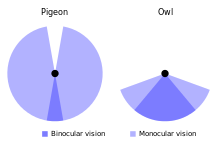
Back Binokulêre visie Afrikaans رؤية ثنائية Arabic Binokulyar görmə Azerbaijani Бинокулярно зрение Bulgarian Visió binocular Catalan Binokulární vidění Czech Binokularsehen German Binocular vision English Duokula vidkapablo Esperanto Visión binocular Spanish


Binocular vision is vision in which both eyes are used together.[1] It can mean having two eyes instead of one, but more often it means having a visual field which is put together by the brain with input from both eyes. This is the standard equipment for vertebrates and many other types of animals.
Humans have a maximum horizontal field of view of about 200 degrees with two eyes. About 120 degrees make up the binocular field of view (seen by both eyes), and two side fields of about 40 degrees seen by only one eye.[2][3]
Our system of vision uses parallax to give precise depth information, called stereopsis.[4] Such binocular vision is usually accompanied by singleness of vision or binocular fusion, in which a single image is seen even though each eye has its own image of an object.[4]
Stereopsis is the impression of depth we get when we look at a scene with both eyes. Binocular viewing of a scene creates two slightly different images of the scene in the two eyes due to the eyes' different positions on the head. These differences give information that the brain uses to calculate depth in the visual scene. The term 'stereopsis' is often used as short hand for 'binocular vision', 'binocular depth perception' or 'stereoscopic depth perception', though strictly speaking, the impression of depth associated with stereopsis can also be got under other conditions, such as when an observer views a scene with only one eye while moving. Observer motion creates differences in the single retinal image over time similar to binocular disparity; this is referred to as motion parallax.
- ↑ The word binocular comes from two Latin roots, bini for double, and oculus for eye. Harper D. 2001. Online etymological dictionary.[1]
- ↑ Henson D.B. 1993. Visual fields. Oxford: Oxford University Press.
- ↑ Blake, Randolph; Fox, Robert (August 1973). "The psychophysical inquiry into binocular summation". Perception & Psychophysics. 14 (1): 161–85. doi:10.3758/BF03198631. S2CID 145783452.
- ↑ 4.0 4.1 Wheatstone, Charles (1838). "Contributions to the physiology of vision.—Part the First. On some remarkable, and hitherto unobserved, phænomena of binocular vision". Philosophical Transactions of the Royal Society of London. 128: 371–394. doi:10.1098/rstl.1838.0019. S2CID 36512205.